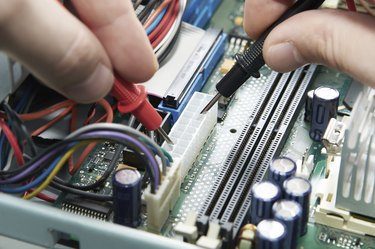
SATA cables come in varied colors besides blue and red, including black, yellow and orange. Some SATA cables even glow in the dark. The differences among SATA cables depends on the types of connector they use and the way you set up your computer hardware. Their colors may help you distinguish among the devices your SATA cables connect, but color alone doesn't signal functional differences among them.
Motherboards
Video of the Day
Red SATA cables are no different from blue SATA cables. You can connect a new hard drive with a blue cable in a system that uses red cables for existing devices. Some component manufacturers color code the slots or ports on their motherboard designs, but unlike sound cards and peripheral ports, which use a standard color code, other port colors don't signal functionality. A manufacturer can choose red or blue ports and cables to match corporate colors.
Video of the Day
Cables
SATA hard drives require two cables, one with 15 pins to supply power and one with 7 pins to carry data. Both cables connect to the rear of the hard drive. The drive's power cable connects to the power supply unit, or PSU. The data cable, which sometimes come packaged with the drive, connects to a SATA slot on the motherboard. Most motherboards' SATA slots carry numbers that start with SATA0 and range upward.
Setups
A mixture of red and blue SATA cables could indicate that a computer's SATA devices don't all connect to the same bus. Some custom PC builders may designate the different buses with different colored cables. On a motherboard that lacks enough SATA ports to meet a your needs, you can plug in a PCI card to add extra SATA ports. The SATA ports you add don't use the same bus as the SATA ports on the motherboard.
eSATA
Some cables support external SATA, or eSATA, devices. Like USB and FireWire drives, these devices connect to the computer externally through an eSATA port. Although eSATA and internal SATA cables may incorporate connectors that look identical, looks can be deceiving. The connectors differ and the cables can't substitute for each other. If you accumulate a collection of spare cables, label them clearly so you can distinguish among them without trial and error.